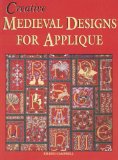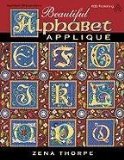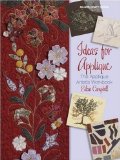|
Links on this page demonstrate many different styles and functions for appliquéd textiles. There are several different ornamental techniques involved with the applied fabric – embroidery was often used to stitch the details onto the appliqué, apparently before it was stitched to the ground cloth – as well as several different methods of attaching the appliqué to the ground cloth, and various edging treatments for outlining the appliqué itself.
There is no singular correct way to do pre-17th century appliqué. If you are attempting to re-create a period style of appliqué, determine the technique that would be appropriate for the sort of project you plan to do. The works linked below can provide some guidance in terms of what had been done in a particular sort of situation, which may help you decide how to do your project.
I’ve also grouped items that are apparently stylistically and/or culturally related; in these cases, I think that viewing multiple items from the same group can help you develop an understanding of how the design and technique worked overall, instead of viewing each separate one in a relative vacuum.
I’ve also included some textiles that were made to be appliquéd, but have either been removed or were never attached to begin with, including several interesting heraldic pieces.
This page does not focus on the use of plaques or other metal ornaments applied to the ground cloth, though there are some examples here which use such ornaments in addition to textile appliqués.
See these links for more information about how to do appliqué.
Last updated: Nov 7, 2021
- Coptic Egyptian applique fragments at the Fitzwilliam:
E.T.1b,
E.T.2a,
E.T.2b,
E.T.2c,
E.T.2d,
E.T.3c,
E.T.3d,
E.T.8,
E.T.38,
E.T.76,
E.T.78,
E.T.85,
E.T.92,
E.T.94,
E.T.125,
E.T.126,
E.T.163,
E.T.145,
E.T.169,
E.T.171,
E.60.1911
APPLIQUÉ FROM MAMLUK EGYPT
- Banner with the arms of the dukes of Savoy with the family arms of de Blonays, 14th century
- The Hildesheim Cope, made in Germany c. 1310-1320. “At the points of the star shapes are appliqued rosettes in couched gold thread.”
- The Tristan Hanging, made in northern Germany c. 1370-1400. “Wall hanging of dark blue cloth with applied figures in coloured cloths and couched gilt leather strip.”
SWEDISH INTARSIA/APPLIQUÉ PANELS
- Altar frontal made in Spain c. 1400. “The armorial design is embroidered in silk and gold thread on pieces of silk and linen, which are cut to shape and applied to the silk background.”
- Embroidered emblem of the Order of the Dragon, made after 1408. “It may have been applied to some part of the Order’s apparel, perhaps a cloak, but might equally have been set into the hangings of the throne, perhaps on the king’s throne or its baldachin, indicating the founder and Grand Master of the Order.”
- Chasuble probably made in Italy c. 1425-1450. “Embroidered orphreys have been appliqued to ground.”
- A cope with the arms of Burgundy and Artois, made in the third quarter of the 15th century (see details 1, 2, 3, 4, 5, 6, 7, 8, 9, 10, 11, 12)
- Panel embroidered in England c. 1470-1500. “It is made from silk velvet, with linen applied and embroidered in silver-gilt and silk threads in couched work and split stitch.”
- Chasuble, c. 1450-1600. The embroidered motifs have been appliqued to a silk band on the orphreys. “The heavy signs of wear on the front orphrey band leave visible the basis on which the embroidery was constructed (linen ground, silk layer and then embroidery, as well as the linen thread padding used for raised areas of the design).”
- Chasuble, c. 1510-1533. “Embroidered in coloured silks, silver-gilt and silver thread and spangles, partly worked on cream-coloured satin, green silk and linen, and afterwards applied.”
- Bed valance made in 16th century Italy. “Silk velvet with padded applique of silver tissue embroidered in coloured silks and couched metal thread.”
- Bed head, or tester, made in France c. 1550-1570. “A pattern of yellow silk strapwork and grotesques applied to a blue satin ground. The satin has been worked over paper, through to a fine linen ground of dark blue, the whole being lined with linen … Throughout, great care has been taken to lend the figures a degree of naturalism; the appliquéd figures’ musculature has been defined with embroidery, and different pelts for the beasts are suggested through the use of embroidered spots, fur and down.”
- A herald’s tabard, 16th century. I am unsure whether it was appliqued (the ornamentation could be paint on the fabric), but it looks that way from the photograph.
- The collar from a dalmatic, probably made in Spain c. 1550-1650. “Stylised appliqué leaves in yellow and blue satin on either side of this central motif. There is a layer of stiffening (paper?) between the appliqué and the velvet base. Round each applied satin motif there is sewn fine yellow silk cording.”
- Burse, c. 1558-1603. “Dark red velvet with applied motifs of canvas, partly covered with red and blue satin, and embroidered with silver and silver-gilt purl, wire, strip and thread, and with some coloured silk thread, spangles and black beads.”
- A cloak with an appliqued border of yellow satin, made from fabric woven in Florence c. 1560-1569, and altered in Spain in 1580-1590
- Applique hanging with rose pattern, England, c. 1580-1590
- Part of a patterned wallhanging, made in England c. 1580-1590. “The design was executed through applying pieces of contrasting coloured fabrics to a ground fabric: the ground is of red felted wool; the applied work of blue, yellow, green and white silk and silk cord with a lattice of yellow scrolls with red slashes containing Tudor roses. Some of the blue silk shows edges of a design in red (i.e. the blue pieces seem to have been cut out from a patterned fabric from which the maker of the hanging has tried to use only the blue areas); the silks have been re-used. The back of the piece is backed with pieces of coarse linen canvas which have been roughly pieced together; the backing is glued to the front (possibly with animal glue).”
- The Creation of Eve and the Temptation panels (Met 60.166.1, 60.166.2, and 40.178), which feature applique silk along with canvaswork, late 16th century, Scottish or British
- Antipendium and chasuble, made in Sweden, 17th century
- Apparel from a set of ecclesiastical ornaments, probably made in Spain c. 1600-1650. “The applique white satin is tinted/painted in black and grey on the skull and elsewhere in blue and red; the applique yellow satin in blue (which creates areas of green). The applique satin is outlined in a couched yellow and white cord, and certain elements of the design are emphasised by the use of a similar couched outline, such as the teeth on the skull.”
17TH CENTURY GLOVES WITH APPLIQUÉ ORNAMENTATION
- Trumpet banner with the royal arms of Charles II, c. 1660. “Red silk damask embroidered in silver tissue applique with blue satin, silver gilt card and red silk.”
|



